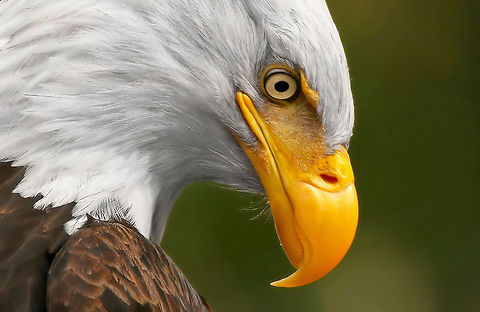
Appearance
The plumage of an adult bald eagle is evenly dark brown with a white head and tail. The tail is moderately long and slightly wedge-shaped. Males and females are identical in plumage coloration, but sexual dimorphism is evident in the species, in that females are 25% larger than males. The beak, feet and irises are bright yellow. The legs are feather-free, and the toes are short and powerful with large talons. The highly developed talon of the hind toe is used to pierce the vital areas of prey while it is held immobile by the front toes. The beak is large and hooked, with a yellow cere. The adult bald eagle is unmistakable in its native range. The closely related African fish eagle also has a brown body, white head and tail, but differs from the bald eagle in having a white chest and black tip to the bill.The plumage of the immature is a dark brown overlaid with messy white streaking until the fifth year, when it reaches sexual maturity. Immature bald eagles are distinguishable from the golden eagle, the only other very large, non-vulturine raptorial bird in North America, in that the former has a larger, more protruding head with a larger beak, straighter edged wings which are held flat and with a stiffer wing beat and feathers which do not completely cover the legs. When seen well, the golden eagle is distinctive in plumage with a more solid warm brown color than an immature bald eagle, with a reddish-golden patch to its nape and a highly contrasting set of white squares on the wing.
The bald eagle has sometimes been considered the largest true raptor in North America. The only larger species of raptor-like bird is the California condor, a New World vulture which today is not generally considered a taxonomic ally of true accipitrids. However, the golden eagle, averaging 4.18 kg and 63 cm in wing chord length in its American race, is merely 455 g lighter in mean body mass and exceeds the bald eagle in mean wing chord length by around 3 cm. Additionally, the bald eagle's close cousins, the relatively longer-winged but shorter-tailed white-tailed eagle and the overall larger Steller's sea eagle, may, rarely, wander to coastal Alaska from Asia.
The bald eagle has a body length of 70–102 cm. Typical wingspan is between 1.8 and 2.3 m and mass is normally between 3 and 6.3 kg. Females are about 25% larger than males, averaging as much as 5.6 kg, and against the males' average weight of 4.1 kg.
The size of the bird varies by location and generally corresponds with Bergmann's rule: the species increases in size further away from the equator and the tropics. For example, eagles from South Carolina average 3.27 kg in mass and 1.88 m in wingspan, smaller than their northern counterparts. One field guide in Florida listed similarly small sizes for bald eagles there, at about 4.13 kg. Of intermediate size, 117 migrant bald eagles in Glacier National Park were found to average 4.22 kg but this was mostly juvenile eagles, with 6 adults here averaging 4.3 kg. Wintering eagles in Arizona were found to average 4.74 kg.
The largest eagles are from Alaska, where large females may weigh more than 7 kg and span 2.44 m across the wings. A survey of adult weights in Alaska showed that females there weighed on average 5.35 kg, respectively, and males weighed 4.23 kg against immatures which averaged 5.09 kg and 4.05 kg in the two sexes. An Alaskan adult female eagle that was considered outsized weighed some 7.4 kg. R.S. Palmer listed a record from 1876 in Wyoming County, New York of an enormous adult bald eagle that was shot and reportedly scaled 8.2 kg. Among standard linear measurements, the wing chord is 51.5–69 cm, the tail is 23–37 cm long, and the tarsus is 8 to 11 cm. The culmen reportedly ranges from 3 to 7.5 cm, while the measurement from the gape to the tip of the bill is 7–9 cm. The bill size is unusually variable: Alaskan eagles can have up to twice the bill length of birds from the southern United States, with means including both sexes of 6.83 cm and 4.12 cm in culmen length, respectively, from these two areas.
The call consists of weak staccato, chirping whistles, "kleek kik ik ik ik", somewhat similar in cadence to a gull's call. The calls of young birds tend to be more harsh and shrill than those of adults.* Grant, Peter J. "The Co. Kerry Bald Eagle" "Twitching" 1: 379–80 – describes plumage differences between bald eagle and white-tailed eagle in juveniles
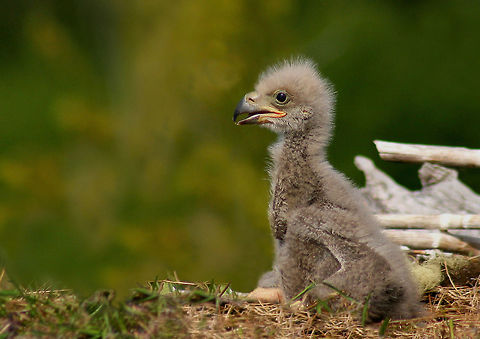
Distribution
Once a common sight in much of the continent, the bald eagle was severely affected in the mid-20th century by a variety of factors, among them the thinning of egg shells attributed to use of the pesticide DDT. Bald eagles, like many birds of prey, were especially affected by DDT due to biomagnification. DDT itself was not lethal to the adult bird, but it interfered with their calcium metabolism, making them either sterile or unable to lay healthy eggs; many of their eggs were too brittle to withstand the weight of a brooding adult, making it nearly impossible for them to hatch. It is estimated that in the early 18th century the bald eagle population was 300,000–500,000, but by the 1950s there were only 412 nesting pairs in the 48 contiguous states of the US.Other factors in bald eagle population reductions were a widespread loss of suitable habitat, as well as both legal and illegal shooting. In 1930 a New York City ornithologist wrote that in the territory of Alaska in the previous 12 years approximately 70,000 bald eagles had been shot. Many of the hunters killed the bald eagles under the long-held beliefs that bald eagles grabbed young lambs and even children with their talons, yet the birds were innocent of most of these alleged acts of predation. Illegal shooting was described as "the leading cause of direct mortality in both adult and immature bald eagles" by the U.S. Fish and Wildlife Service in 1978. Leading causes of death in bald eagles include lead pollution, poisoning, collision with motor vehicles, and power-line electrocution. A study published in 2022 in the journal Science found that more than half of adult eagles across 38 US states suffered from lead poisoning. The primary cause is when eagles scavenge carcasses of animals shot by hunters. These are often tainted with lead shotgun pellets or rifle rounds, ammunition fragments.
The species was first protected in the U.S. and Canada by the 1918 Migratory Bird Treaty, later extended to all of North America. The Bald and Golden Eagle Protection Act, approved by the U.S. Congress in 1940, protected the bald eagle and the golden eagle, prohibiting commercial trapping and killing of the birds. The bald eagle was declared an endangered species in the U.S. in 1967, and amendments to the 1940 act between 1962 and 1972 further restricted commercial uses and increased penalties for violators. Perhaps most significant in the species' recovery, in 1972, DDT was banned from usage in the United States due to the fact that it inhibited the reproduction of many birds. DDT was completely banned in Canada in 1989, though its use had been highly restricted since the late 1970s.
With regulations in place and DDT banned, the eagle population rebounded. The bald eagle can be found in growing concentrations throughout the United States and Canada, particularly near large bodies of water. In the early 1980s, the estimated total population was 100,000 individuals, with 110,000–115,000 by 1992; the U.S. state with the largest resident population is Alaska, with about 40,000–50,000, with the next highest population the Canadian province of British Columbia with 20,000–30,000 in 1992. Obtaining a precise count of the bald eagle population is extremely difficult. The most recent data submitted by individual states was in 2006, when 9789 breeding pairs were reported. For some time, the stronghold breeding population of bald eagles in the lower 48 states was in Florida, where over a thousand pairs have held on while populations in other states were significantly reduced by DDT use. Today, the contiguous state with the largest number of breeding pairs of eagles is Minnesota with an estimated 1,312 pairs, surpassing Florida's most recent count of 1,166 pairs. 23, or nearly half, of the 48 contiguous states now have at least 100 breeding pairs of bald eagles. In Washington State, there were only 105 occupied nests in 1980. That number increased by about 30 per year, so that by 2005 there were 840 occupied nests. 2005 was the last year that the Washington Department of Fish and Wildlife counted occupied nests. Further population increases in Washington may be limited by the availability of late winter food, particularly salmon.
The bald eagle was officially removed from the U.S. federal government's list of endangered species on July 12, 1995, by the U.S. Fish & Wildlife Service, when it was reclassified from "endangered" to "threatened". On July 6, 1999, a proposal was initiated "To Remove the Bald Eagle in the Lower 48 States From the List of Endangered and Threatened Wildlife". It was de-listed on June 28, 2007. It has also been assigned a risk level of least concern category on the IUCN Red List. In the "Exxon Valdez" oil spill of 1989 an estimated 247 were killed in Prince William Sound, though the local population returned to its pre-spill level by 1995. In some areas, the increase in eagles has led to decreases in other bird populations and the eagles may be considered a pest.

Behavior
The bald eagle is a powerful flier, and soars on thermal convection currents. It reaches speeds of 56–70 km/h when gliding and flapping, and about 48 km/h while carrying fish. Its dive speed is between 120–160 km/h, though it seldom dives vertically. Regarding their flying abilities, despite being morphologically less well adapted to faster flight than golden eagles, the bald eagle is considered surprisingly maneuverable in flight. Bald eagles have also been recorded catching up to and then swooping under geese in flight, turning over and thrusting their talons into the other bird's breast. It is partially migratory, depending on location. If its territory has access to open water, it remains there year-round, but if the body of water freezes during the winter, making it impossible to obtain food, it migrates to the south or to the coast. A number of populations are subject to post-breeding dispersal, mainly in juveniles; Florida eagles, for example, will disperse northwards in the summer. The bald eagle selects migration routes which take advantage of thermals, updrafts, and food resources. During migration, it may ascend in a thermal and then glide down, or may ascend in updrafts created by the wind against a cliff or other terrain. Migration generally takes place during the daytime, usually between the local hours of 8:00 a.m. and 6:00 p.m., when thermals are produced by the sun.To hunt fish, the eagle swoops down over the water and snatches the fish out of the water with its talons. They eat by holding the fish in one claw and tearing the flesh with the other. Eagles have structures on their toes called spicules that allow them to grasp fish. Osprey also have this adaptation. Bird prey may occasionally be attacked in flight, with prey up to the size of Canada geese attacked and killed in mid-air. It has been estimated that the gripping power of the bald eagle is ten times greater than that of a human. Bald eagles can fly with fish at least equal to their own weight, but if the fish is too heavy to lift, the eagle may be dragged into the water. Bald eagles are able to swim, in some cases dragging its catch ashore with its talons, but some eagles drown or succumb to hypothermia. Many sources claim that bald eagles, like all large eagles, cannot normally take flight carrying prey more than half of their own weight unless aided by favorable wind conditions. On numerous occasions, when large prey such as large fish including mature salmon or geese are attacked, eagles have been seen to make contact and then drag the prey in a strenuously labored, low flight over the water to a bank, where they then finish off and dismember the prey. When food is abundant, an eagle can gorge itself by storing up to 1 kg of food in a pouch in the throat called a crop. Gorging allows the bird to fast for several days if food becomes unavailable. Occasionally, bald eagles may hunt cooperatively when confronting prey, especially relatively large prey such as jackrabbits or herons, with one bird distracting potential prey, while the other comes behind it in order to ambush it. While hunting waterfowl, bald eagles repeatedly fly at a target and cause it to dive repeatedly, hoping to exhaust the victim so it can be caught. When hunting concentrated prey, a successful catch often results in the hunting eagle being pursued by other eagles and needing to find an isolated perch for consumption if it is able to carry it away successfully.They obtain much of their food as carrion or via a practice known as kleptoparasitism, by which they steal prey away from other predators. Due to their dietary habits, bald eagles are frequently viewed in a negative light by humans. Thanks to their superior foraging ability and experience, adults are generally more likely to hunt live prey than immature eagles, which often obtain their food from scavenging. They are not very selective about the condition or origin, whether provided by humans, other animals, auto accidents or natural causes, of a carcass's presence, but will avoid eating carrion where disturbances from humans are a regular occurrence. They will scavenge carcasses up to the size of whales, though carcasses of ungulates and large fish are seemingly preferred. Congregated wintering waterfowl are frequently exploited for carcasses to scavenge by immature eagles in harsh winter weather. Bald eagles also may sometimes feed on material scavenged or stolen from campsites and picnics, as well as garbage dumps and fish-processing plants.
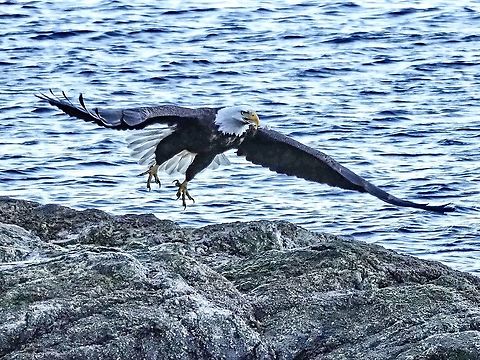
Habitat
The bald eagle occurs during its breeding season in virtually any kind of American wetland habitat such as seacoasts, rivers, large lakes or marshes or other large bodies of open water with an abundance of fish. Studies have shown a preference for bodies of water with a circumference greater than 11 km, and lakes with an area greater than 10 km2 are optimal for breeding bald eagles.The bald eagle typically requires old-growth and mature stands of coniferous or hardwood trees for perching, roosting, and nesting. Tree species reportedly is less important to the eagle pair than the tree's height, composition and location. Perhaps of paramount importance for this species is an abundance of comparatively large trees surrounding the body of water. Selected trees must have good visibility, be over 20 m tall, an open structure, and proximity to prey. If nesting trees are in standing water such as in a mangrove swamp, the nest can be located fairly low, at as low 6 m above the ground. In a more typical tree standing on dry ground, nests may be located from 16 to 38 m in height. In Chesapeake Bay, nesting trees averaged 82 cm in diameter and 28 m in total height, while in Florida, the average nesting tree stands 23 m high and is 23 cm in diameter. Trees used for nesting in the Greater Yellowstone area average 27 m high. Trees or forest used for nesting should have a canopy cover of no more than 60%, and no less than 20%, and be in close proximity to water. Most nests have been found within 200 m of open water. The greatest distance from open water recorded for a bald eagle nest was over 3 km, in Florida.
Bald eagle nests are often very large in order to compensate for size of the birds. The largest recorded nest was found in Florida in 1963, and was measured at nearly 10 feet wide and 20 feet deep.
In Florida, nesting habitats often consist of Mangrove swamps, the shorelines of lakes and rivers, pinelands, seasonally flooded flatwoods, hardwood swamps, and open prairies and pastureland with scattered tall trees. Favored nesting trees in Florida are slash pines, longleaf pines, loblolly pines and cypress trees, but for the southern coastal areas where mangroves are usually used. In Wyoming, groves of mature cottonwoods or tall pines found along streams and rivers are typical bald eagle nesting habitats. Wyoming eagles may inhabit habitat types ranging from large, old-growth stands of ponderosa pines to narrow strips of riparian trees surrounded by rangeland. In Southeast Alaska, Sitka spruce provided 78% of the nesting trees used by eagles, followed by hemlocks at 20%. Increasingly, eagles nest in human-made reservoirs stocked with fish.
The bald eagle is usually quite sensitive to human activity while nesting, and is found most commonly in areas with minimal human disturbance. It chooses sites more than 1.2 km from low-density human disturbance and more than 1.8 km from medium- to high-density human disturbance. However, bald eagles will occasionally nest in large estuaries or secluded groves within major cities, such as Hardtack Island on the Willamette River in Portland, Oregon or John Heinz National Wildlife Refuge at Tinicum in Philadelphia, Pennsylvania, which are surrounded by a great quantity of human activity. Even more contrary to the usual sensitivity to disturbance, a family of bald eagles moved to the Harlem neighborhood in New York City in 2010.
While wintering, bald eagles tend to be less habitat and disturbance sensitive. They will commonly congregate at spots with plentiful perches and waters with plentiful prey and partially unfrozen waters. Alternately, non-breeding or wintering bald eagles, particularly in areas with a lack of human disturbance, spend their time in various upland, terrestrial habitats sometimes quite far away from waterways. In the northern half of North America, this terrestrial inhabitance by bald eagles tends to be especially prevalent because unfrozen water may not be accessible. Upland wintering habitats often consist of open habitats with concentrations of medium-sized mammals, such as prairies, meadows or tundra, or open forests with regular carrion access.
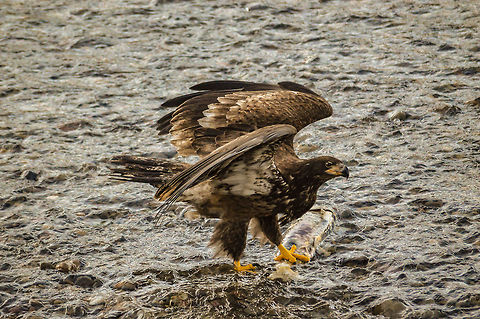
Reproduction
Bald eagles are sexually mature at four or five years of age. When they are old enough to breed, they often return to the area where they were born. It is thought that bald eagles mate for life. However, if one member of a pair dies or disappears, the survivor will choose a new mate. A pair which has repeatedly failed in breeding attempts may split and look for new mates. Bald eagle courtship involves elaborate, spectacular calls and flight displays by the males. The flight includes swoops, chases, and cartwheels, in which they fly high, lock talons, and free-fall, separating just before hitting the ground. Usually, a territory defended by a mature pair will be 1 to 2 km of waterside habitat.Compared to most other raptors, which mostly nest in April or May, bald eagles are early breeders: nest building or reinforcing is often by mid-February, egg laying is often late February, and incubation is usually mid-March and early May. Eggs hatch from mid April to early May, and the young fledge late June to early July. The nest is the largest of any bird in North America; it is used repeatedly over many years and with new material added each year may eventually be as large as 4 m deep, 2.5 m across and weigh 1 metric ton. One nest in Florida was found to be 6.1 m deep, 2.9 meters across, and to weigh 3 short tons. This nest is on record as the largest tree nest ever recorded for any animal. Usually nests are used for under five years, as they either collapse in storms or break the branches supporting them by their sheer weight. However, one nest in the Midwest was occupied continuously for at least 34 years. The nest is built of branches, usually in large trees found near water. When breeding where there are no trees, the bald eagle will nest on the ground, as has been recorded largely in areas largely isolated from terrestrial predators, such as Amchitka Island in Alaska.
In Sonora, Mexico, eagles have been observed nesting on top of hecho catcuses. Nests located on cliffs and rock pinnacles have been reported historically in California, Kansas, Nevada, New Mexico and Utah, but currently are only verified to occur only in Alaska and Arizona. The eggs average about 73 mm long, ranging from 58 to 85 mm, and have a breadth of 54 mm, ranging from 47 to 63 mm. Eggs in Alaska averaged 130 g in mass, while in Saskatchewan they averaged 114.4 g. As with their ultimate body size, egg size tends to increase with distance from the equator. Eagles produce between one and three eggs per year, two being typical. Rarely, four eggs have been found in nests, but these may be exceptional cases of polygyny. Eagles in captivity have been capable of producing up to seven eggs. It is rare for all three chicks to successfully reach the fledgling stage. The oldest chick often bears the advantage of larger size and louder voice, which tends to draw the parents' attention towards it. Occasionally, as is recorded in many large raptorial birds, the oldest sibling sometimes attacks and kills its younger sibling, especially early in the nesting period when their sizes are most different. However, nearly half of known bald eagles produce two fledglings, unlike in some other "eagle" species such as some in the genus "Aquila", in which a second fledgling is typically observed in less than 20% of nests, despite two eggs typically being laid. Both the male and female take turns incubating the eggs, but the female does most of the sitting. The parent not incubating will hunt for food or look for nesting material during this stage. For the first two to three weeks of the nestling period, at least one adult is at the nest almost 100% of the time. After five to six weeks, the attendance of parents usually drops off considerably.
A young eaglet can gain up to 170 g a day, the fastest growth rate of any North American bird. The young eaglets pick up and manipulate sticks, play tug of war with each other, practice holding things in their talons, and stretch and flap their wings. By eight weeks, the eaglets are strong enough to flap their wings, lift their feet off the nest platform, and rise up in the air. The young fledge at anywhere from 8 to 14 weeks of age, though will remain close to the nest and attended to by their parents for a further 6 weeks. Juvenile eagles first start dispersing away from their parents about 8 weeks after they fledge. Variability in departure date related to effects of sex and hatching order on growth and development. For the next four years, immature eagles wander widely in search of food until they attain adult plumage and are eligible to reproduce.
On rare occasions, bald eagles have been recorded to adopt other raptor fledglings into their nests, as seen in 2017 by a pair of eagles in Shoal Harbor Migratory Bird Sanctuary near Sidney, British Columbia. The pair of eagles in question are believed to have carried a juvenile red-tailed hawk back to their nest, presumably as prey, whereupon the chick was accepted into the family by both the parents and the eagles' three nestlings. The hawk, nicknamed "Spunky" by biologists monitoring the nest, fledged successfully.
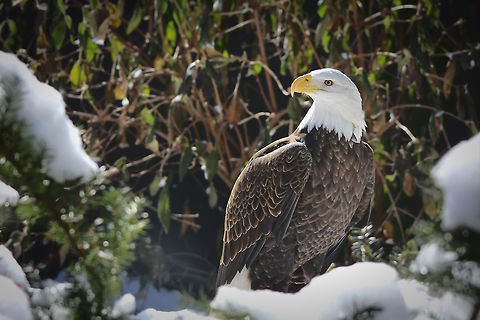
Food
The bald eagle is an opportunistic carnivore with the capacity to consume a great variety of prey. Fish often comprise most of the eagle's diet throughout their range. In 20 food habit studies across the species' range, fish comprised 56% of the diet of nesting eagles, birds 28%, mammals 14% and other prey 2%. More than 400 species are known to be included in the bald eagle's prey spectrum, far more than its ecological equivalent in the Old World, the white-tailed eagle, is known to take. Despite its considerably lower population, the bald eagle may come in second amongst all North American accipitrids, slightly behind only the red-tailed hawk, in number of prey species recorded.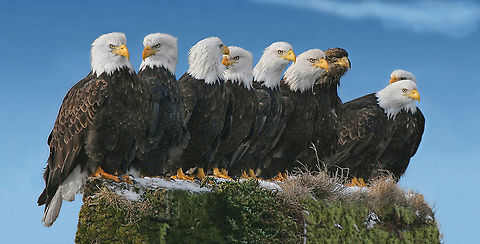
Predators
The average lifespan of bald eagles in the wild is around 20 years, with the oldest confirmed one having been 38 years of age. In captivity, they often live somewhat longer. In one instance, a captive individual in New York lived for nearly 50 years. As with size, the average lifespan of an eagle population appears to be influenced by its location and access to prey. As they are no longer heavily persecuted, adult mortality is quite low. In one study of Florida eagles, adult bald eagles reportedly had 100% annual survival rate. In Prince William Sound in Alaska, adults had an annual survival rate of 88% even after the Exxon Valdez oil spill adversely affected eagles in the area. Of 1,428 individuals from across the range necropsied by National Wildlife Health Center from 1963 to 1984, 329 eagles died from trauma, primarily impact with wires and vehicles; 309 died from gunshot; 158 died from poisoning; 130 died from electrocution; 68 died from trapping; 110 from emaciation; and 31 from disease; cause of death was undetermined in 293 of cases. In this study, 68% of mortality was human-caused. Today, eagle-shooting is believed to be considerably reduced due to the species' protected status. In one case, an adult eagle investigating a peregrine falcon nest for prey items sustained a concussion from a swooping parent peregrine, and ultimately died days later from it. An early natural history video depicting a cougar ambushing and killing an immature bald eagle feeding at a rabbit carcass is viewable online, although this film may have been staged.Most non-human-related mortality involves nestlings or eggs. Around 50% of eagles survive their first year. However, in the Chesapeake Bay area, 100% of 39 radio-tagged nestlings survived to their first year. Nestling or egg fatalities may be due to nest collapses, starvation, sibling aggression or inclement weather. Another significant cause of egg and nestling mortality is predation. Nest predators include large gulls, corvids, wolverines, fishers, red-tailed hawks, owls, other eagles, bobcats, American black bears and raccoons. If food access is low, parental attendance at the nest may be lower because both parents may have to forage, thus resulting in less protection. Nestlings are usually exempt from predation by terrestrial carnivores that are poor tree-climbers, but Arctic foxes occasionally snatched nestlings from ground nests on Amchitka Island in Alaska before they were extirpated from the island. The bald eagle will defend its nest fiercely from all comers and has even repelled attacks from bears, having been recorded knocking a black bear out of a tree when the latter tried to climb a tree holding nestlings.
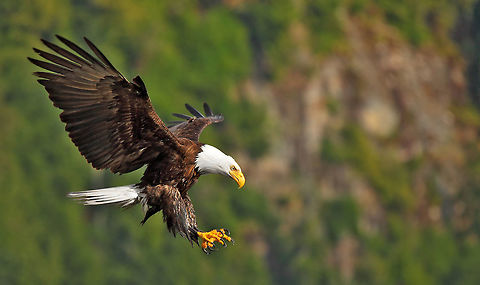
Cultural
The bald eagle is important in various Native American cultures and, as the national bird of the United States, is prominent in seals and logos, coinage, postage stamps, and other items relating to the U.S. federal government.The bald eagle is a sacred bird in some North American cultures, and its feathers, like those of the golden eagle, are central to many religious and spiritual customs among Native Americans. Eagles are considered spiritual messengers between gods and humans by some cultures. Many pow wow dancers use the eagle claw as part of their regalia as well. Eagle feathers are often used in traditional ceremonies, particularly in the construction of regalia worn and as a part of fans, bustles and head dresses. In the Navajo tradition an eagle feather is represented to be a protector, along with the feather Navajo medicine men use the leg and wing bones for ceremonial whistles. The Lakota, for instance, give an eagle feather as a symbol of honor to person who achieves a task. In modern times, it may be given on an event such as a graduation from college. The Pawnee consider eagles as symbols of fertility because their nests are built high off the ground and because they fiercely protect their young. The Choctaw consider the bald eagle, who has direct contact with the upper world of the sun, as a symbol of peace.During the Sun Dance, which is practiced by many Plains Indian tribes, the eagle is represented in several ways. The eagle nest is represented by the fork of the lodge where the dance is held. A whistle made from the wing bone of an eagle is used during the course of the dance. Also during the dance, a medicine man may direct his fan, which is made of eagle feathers, to people who seek to be healed. The medicine man touches the fan to the center pole and then to the patient, in order to transmit power from the pole to the patient. The fan is then held up toward the sky, so that the eagle may carry the prayers for the sick to the Creator.
Current eagle feather law stipulates that only individuals of certifiable Native American ancestry enrolled in a federally recognized tribe are legally authorized to obtain or possess bald or golden eagle feathers for religious or spiritual use. The constitutionality of these laws has been questioned by Native American groups on the basis that it violates the First Amendment by affecting ability to practice their religion freely.
The National Eagle Repository, a division of the FWS, exists as a means to receive, process, and store bald and golden eagles which are found dead and to distribute the eagles, their parts and feathers to federally recognized Native American tribes for use in religious ceremonies.Largely because of its role as a symbol of the United States, but also because of its being a large predator, the bald eagle has many representations in popular culture. In film and television depictions the call of the red-tailed hawk, which is much louder and more powerful, is often substituted for bald eagles.
References:
Some text fragments are auto parsed from Wikipedia.